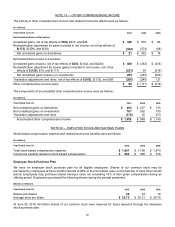Microsoft 2010 Annual Report Download - page 72
Download and view the complete annual report
Please find page 72 of the 2010 Microsoft annual report below. You can navigate through the pages in the report by either clicking on the pages listed below, or by using the keyword search tool below to find specific information within the annual report.
71
Online Services Division – Online Services Division consists of an online advertising platform with offerings for both
publishers and advertisers, online information offerings, such as Bing, and the MSN portals and channels around the
world.
Microsoft Business Division – Microsoft Business Division offerings include Microsoft Office, SharePoint, and
Microsoft Dynamics business solutions.
Entertainment and Devices Division – Entertainment and Devices Division offerings include the Xbox 360 platform,
the Zune digital music and entertainment platform, PC software games, online games and services, Mediaroom (our
Internet protocol television software), Windows Phone, Windows Embedded device platforms, application software
for Apple’s Macintosh computers, and Microsoft PC hardware products.
Due to the integrated structure of our business, certain costs incurred by one segment may benefit other segments.
The costs that are identifiable are allocated to the segments that benefit to incent cross-collaboration among our
segments so that one segment is not solely burdened by the cost of a mutually beneficial activity. Each allocation is
measured differently based on the specific facts and circumstances of the costs being allocated. These cost
allocations were not material in any period presented.
In addition, certain costs incurred at a corporate level that are identifiable and that benefit our segments are allocated
to them. These allocated costs include costs of: field selling; employee benefits; shared facilities services; and
customer service and support. Each allocation is measured differently based on the specific facts and circumstances
of the costs being allocated. Certain other corporate-level activity is not allocated to our segments, including costs of:
broad-based sales and marketing; product support services; human resources; legal; finance; information
technology; corporate development and procurement activities; research and development; legal settlements and
contingencies; and employee severance.
Assets are not allocated to segments for internal reporting presentations. A portion of amortization and depreciation
is included with various other costs in an overhead allocation to each segment and it is impracticable for us to
separately identify the amount of amortization and depreciation by segment that is included in the measure of
segment profit or loss.
Reconciling amounts in the tables above and below include adjustments to conform our internal accounting policies
to U.S. GAAP and corporate-level activity not specifically attributed to a segment. Significant internal accounting
policies that differ from U.S. GAAP relate to revenue recognition, income statement classification, depreciation, and
amortization of stock-based awards.
Significant reconciling items were as follows:
(In millions)
Y
ear Ended June 30, 2010
2009 2008
Corporate-level activity (a) $(4,470 )
$ (4,542) $ (6,026)
Stock-based compensation expense 571
770 790
Revenue reconciling amounts 369
256 396
Other 732
(19) 14
Total $ (2,798 )
$ (3,535) $ (4,826)
(a) Corporate-level activity excludes stock-based compensation expense and revenue reconciling amounts
presented separately in those line items.
No sales to an individual customer accounted for more than 10% of fiscal year 2010, 2009, or 2008 revenue.
Revenue, classified by the major geographic areas in which our customers are located, was as follows:
(In millions)
Y
ear Ended June 30, 2010
2009 2008
United States (a) $36,173
$ 33,052 $ 35,928
Other countries 26,311
25,385 24,492
Total $ 62,484
$ 58,437 $ 60,420






















